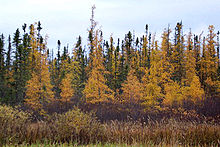Bog forest
A bog forest is a forest on locations with water-saturated soil, with layers of peat . Bog forests grow on more or less acidic, mostly nutrient-poor, locations on the wetland boundary of the forest. The swamp forests , which are just as heavily watered, are similar to and often adjacent to bog forests , but are more nutrient-rich, especially richer in nitrogen. The C / N ratio in the bog forest is 21 to 26, in the quarry forest 12 to 16, and is therefore more favorable for the growth of most plant species than in the bog forest. In Central Europe, peat forests are mostly of Scots pine or downy birch , in the Alps and in the foothills of the Alps also Spirke or spruce dominated, while mostly in swamp forests alder dominated. Occasionally, however, the birch and pine bog forests are also referred to as birch or pine break.
Bog forests are often in contact with the tree-hostile open raised bogs . They grow, for example, on partially drained moors. In addition, they also dominate natural, undisturbed moors in areas with a continental climate or arched moors living on the drier slopes.
As LRT 91D0 *, peat forests are a priority protected habitat type according to the Habitats Directive of the European Union.
Locations and distribution
Bog forests in Central Europe

Bog forests grow on peat of continental raised bog complexes , on the slopes and on the edges of the lagoons of raised bogs in less continental areas and on the edges of dystrophic waters. Other places of growth are drained, no longer growing raised bogs (secondary forests). In addition to bog soils , very wet, boggy , mineral wet soils and nutrient-rich fens are also colonized. Depending on the nutrient supply, peat forests in these locations often only develop thin layers of trees on acidic locations . In very acidic locations (central raised bog areas), only bog trees with mostly limited vigor can develop. With increasingly more favorable nutrient supply to the locations, these woody plants take on a forest character. The herb layer is often characterized by the dominance of peat moss (Sphagnum) and dwarf shrubs ( Vaccinium ).
- Bog berries-Scots pine bog forest (Vaccinio uliginosi-Pinetum sylvestris): These are natural, light bog forests with a sparse tree layer of Scots pines ( Pinus sylvestris ) and downy birches ( Betula pubescens ).
- Carpathian birch quarry forest (Betuletum carpaticae): Light birch bog forest with Carpathian birch ( Betula pubescens ssp. Carpatica , a subspecies of the bog birch ) on the edges of swelling high and intermediate moors in the montane layers of the low mountain range .
- Birch quarry forest (Betuletum pubescentis): Light birch quarry forest, birch bog forest with downy birch on nutrient-poor peat soils on the edge of raised and intermediate bogs as well as dystrophic waters in the wet oligotrophic area.
Bog forests in North and South America
In the boreal zone of North America, bog forests with black spruce Picea mariana and Larix laricina as well as the occidental arborvitae ( Thuja occidentalis ) have developed. In the south and southeast of the United States there are swamp moors and swamp forests, which are composed of the bald cypress ( Taxodium distichum ) and the tupelo tree ( Nyssa aquatica ). The best-known example is the Everglades in the southern United States. They are flood plains in foot valleys and coastal areas or swamp moors fed by inflow water.
Peat forests in Southeast Asia
Indonesia's forests grew predominantly on thick peat beds . The largest peat forests in the world can be found here, the trees of which can grow up to 50 meters high. The forests cover about 20 million hectares. About 120 species of trees grow on one hectare. The high variety of pitcher plants is characteristic of these forests . The causes of the peat formation are a very slight slope of the terrain, the rising sea level after the last ice age and the water masses that the rivers bring from the interior to the coastal plains. In the rainy season, the water accumulates and floods the forest floor for months.
See also
literature
- M. Succow, M. Jeschke: Moors in the landscape: origin, household, living world, distribution, use and preservation of moors . Thun, Frankfurt / Main, 1990, ISBN 3-87144-954-7
Individual evidence
- ↑ Heinz Ellenberg (continued by Christoph Leuschner): Vegetation of Central Europe with the Alps, from an ecological, dynamic and historical perspective. 6th, extended edition 2010. 1334 pages. ISBN 978-3-8252-8104-5 . Eugen Ulmer Verlag, Stuttgart 2010 (UTB Volume 8104). on page 422.
- ↑ cf. Henning Häupler (2002): The biotopes of Germany. Publication series for vegetation science 38: 247–272. PDF ( Memento of the original dated August 2, 2018 in the Internet Archive ) Info: The archive link was inserted automatically and has not yet been checked. Please check the original and archive link according to the instructions and then remove this notice.
- ↑ Moor forests, NATURA 2000 code: * 91D0 BfN Federal Agency for Nature Conservation, last changed on January 16, 2012.
Web links
- Peat forests in Indonesia ( Memento of April 5, 2013 in the Internet Archive ) PDF, page 27, accessed on July 14, 2006


